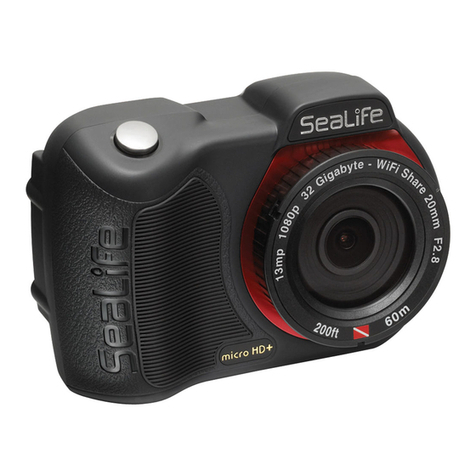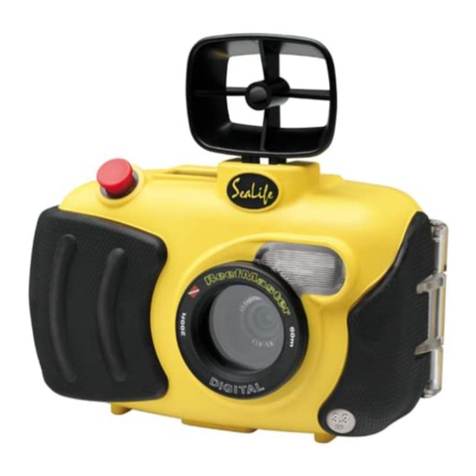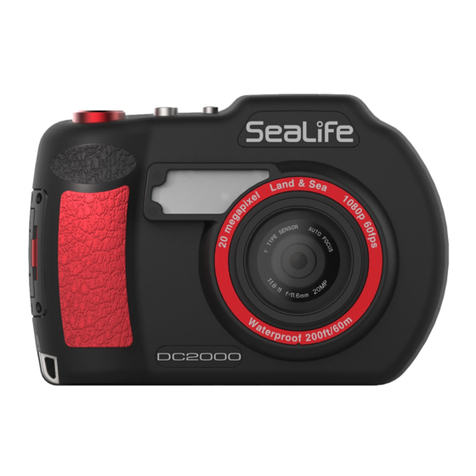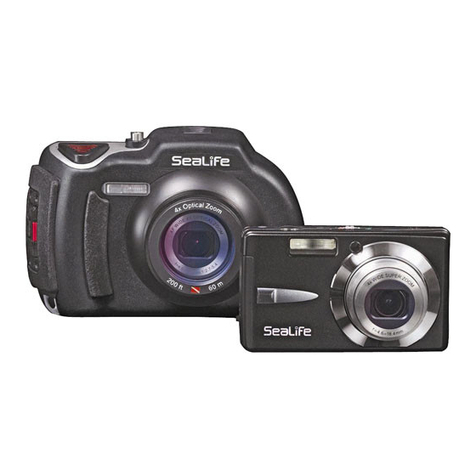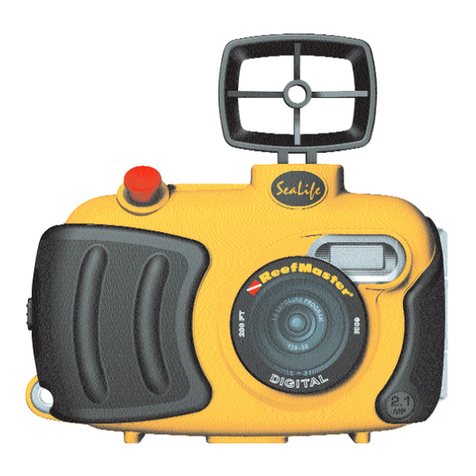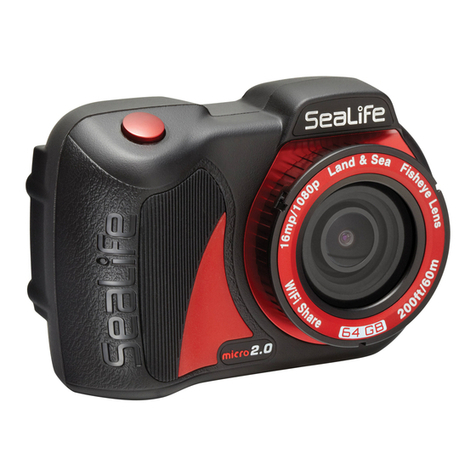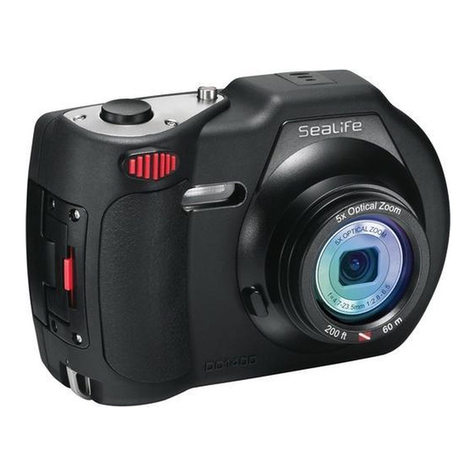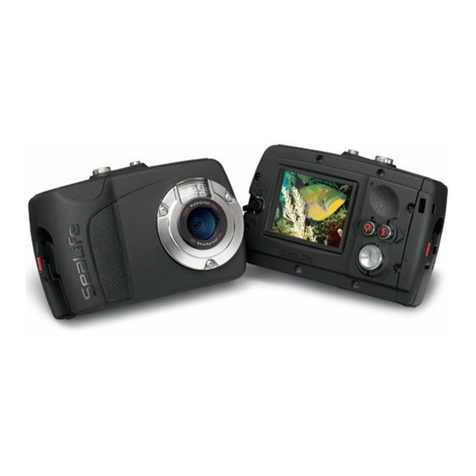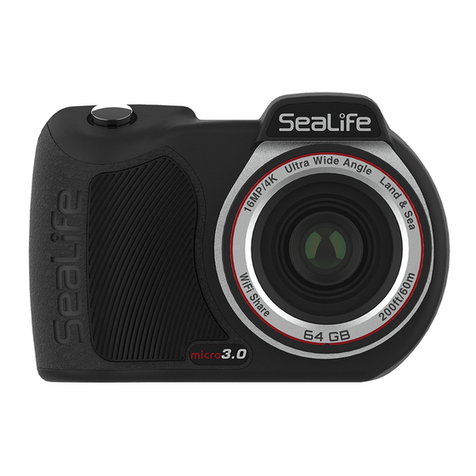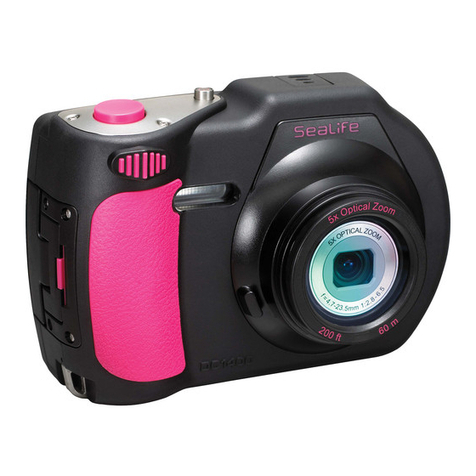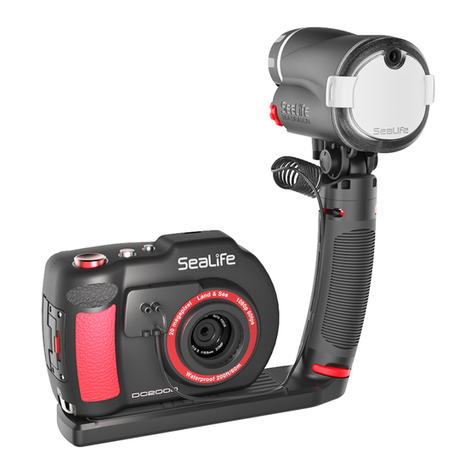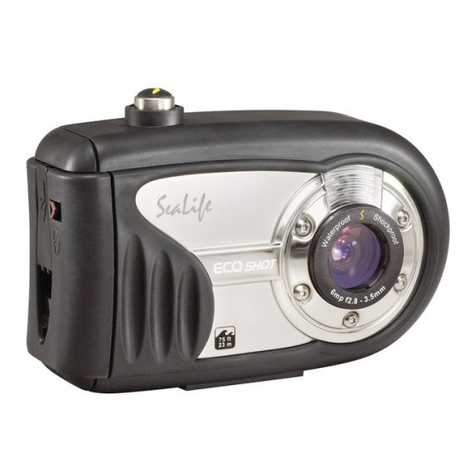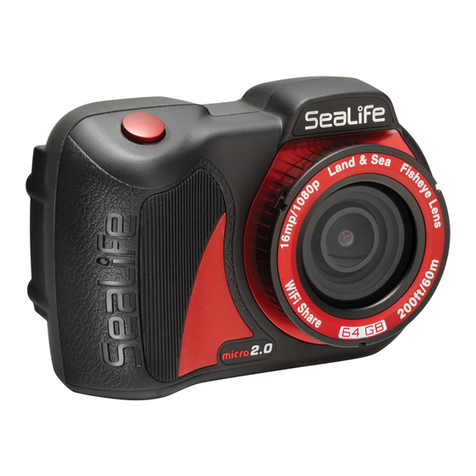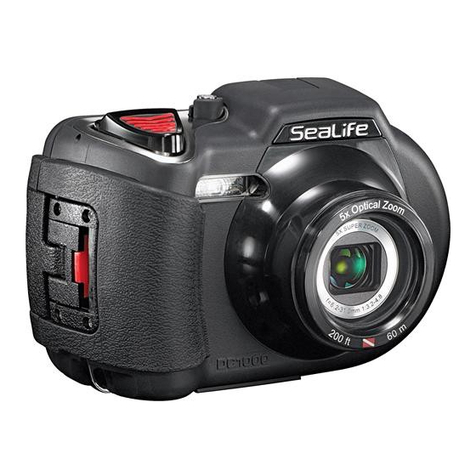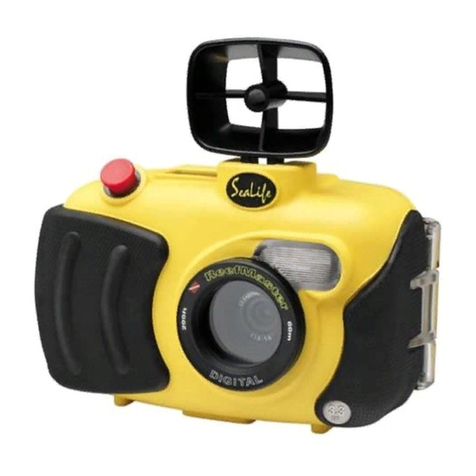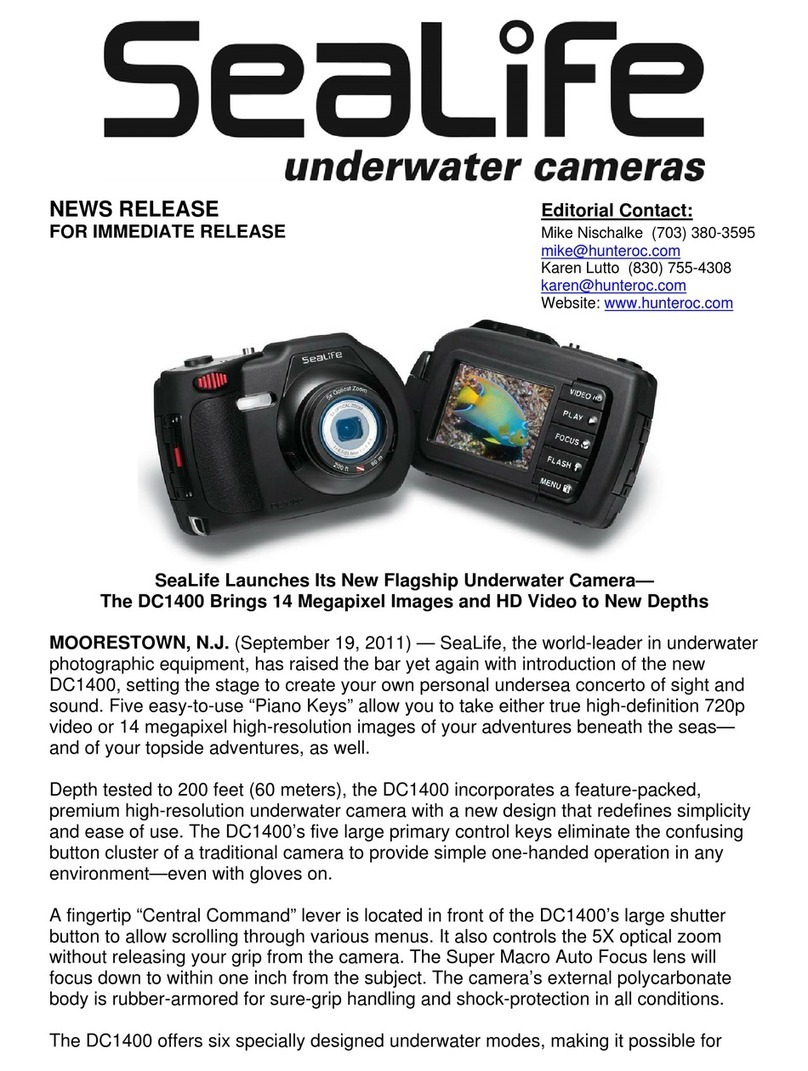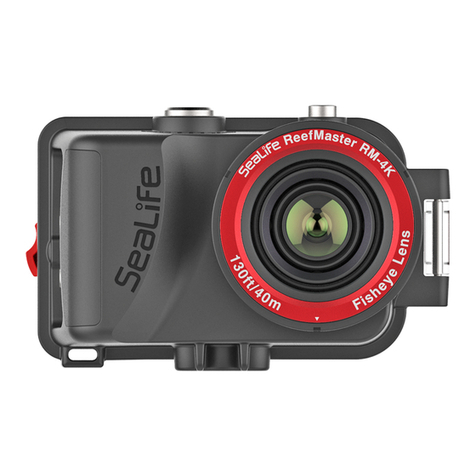Prepare housing
a. Carefully inspect the O-ring and O-ring contact surfaces for cuts, scratches, or any other damage.
b. O-ring and O-ring contact surfaces must be perfectly clean. No hair, sand, or other debris.
Use cleaning brush to clean.
c.Check that O-ring is completely seated into o-ring groove, and that o-ring is not twisted before sealing the housing.
Refer to instruction manual on how to remove and install o-ring.
d.Insert one Moisture Muncher desiccant capsule (SL911) in slot provided.
e. Inside of housing and inner camera must be totally dry.Remove strap from camera.
f. Make sure there are no obstructions when closing the waterproof housing. Latch must “click” into place.
Preparar la carcasa
a. Detenidamente examine la junta ylas superficies de contacto de la junta para ver si tienen cortes, rayones o
cualquier otro daño.
b.Lajunta y las superficies de contacto de la junta deben estar perfectamente limpias. Sin pelos, arena u otros residuos.
Use un cepillo para limpiarlas.
c.Antes de cerrar herméticamente la carcasa, verifique que la junta está completamente asentada en su ranura y que
noestá retorcida. Consulte el manual de instrucciones para ver como se quita y se instala la junta.
d. Inserte una cápsula de absorbente de humedad Moisture Muncher (SL911) en la ranura provista.
e. El interior de la carcasa y el interior de la cámara deben estar totalmente secos. Retire la correa de la cámara.
f. Asegúrese de que no haya ningún impedimento al cerrar la carcasa hermética. El pestillo debe encajar en su sitio
con un “clic”.
Preparare la custodia
a. Ispezionare attentamente l'O-ring ele relative superfici di contatto per verificare che non siano presenti tagli,
graffi o altri danni.
b. L'O-ring e le relative superfici di contatto devono essere perfettamente puliti e privi di capelli, sabbia o altri residui.
Pulire con un apposito spazzolino.
c. Prima di chiudere la custodia, verificare che l'O-ring sia perfettamente alloggiato nell'apposita scanalatura e che non
sia attorcigliato. Per indicazioni su come rimuovere e installare l'O-ring, consultare il manuale d'istruzioni.
d.Inserire una capsula di essiccante Moisture Muncher (SL911) nell'apposita fessura.
e. L'interno della custodia e quello della fotocamera devono essere completamente asciutti.Rimuovere il cinturino
dalla fotocamera.
f. Quando si chiude la custodia impermeabile, assicurarsi che non vi siano ostruzioni. Il dispositivo di chiusura deve
scattare in posizione con un “clic”.
Préparation du boîtier
a. Inspectez le joint d’étanchéité et ses surfaces de contact pour vous assurer qu’il n’y a aucune coupure, rayure ni
unautre dommage.
b. Le joint et les surfaces de contact doivent être parfaitement propres, sans grain de sable, cheveu ou autre débris.
Utilisez un pinceau pour les nettoyer si besoin.
c. Vérifiez que le joint est bien à fond dans sa rainure et qu’il n’est pas entortillé avant de fermer le boîtier. Pour enlever
et replacer le joint, consultez le manuel d’utilisation.
d.Insérez une capsule de déshydratant Moisture Muncher (SL911) à l’emplacement prévu.
e. L’intérieur du boîtier et celui de l’appareil photo doivent être totalement secs.Enlevez la dragonne de l’appareil.
f. Vérifiez que rien ne fait obstruction lorsque vous fermez le boîtier étanche. Sa fermeture doit s’encliquer nettement.
Gehäuse vorbereiten
a. Sorgfältig den O-Ring inspizieren sowie die Oberfläche des O-Rings auf Schnitte, Kratzer oder andere Schäden prüfen.
b. O-Ring und O-Ring-Dichtungsflächen müssen vollkommen sauber sein, freivon Haaren, Sand, oder
Verschmutzungen. Benutzen Sie eine feine Bürste zum Säubern.
c. Prüfen Sie, dass der O-Ring vollständig in der O-Ring-Rille liegt, und dass er vor dem Schliessen des Gehäuses nicht
verdreht ist.
Die Gebrauchsanweisung erklärt das Entfernen und Einlegen des O-Rings.
d. Fügen Sie eine „MoistureMuncher“ Anti-Beschlag Trockenmittelkapsel (Art. Nr.SL911) ein.
e. Die Innenseite des Gehäuses und die innere Kamera müssen vollständig trocken sein. Entfernen Sie das Trageband von der inneren Kamera.
f. Stellen Sie sicher, dass die Kamera leicht und ohne Hindernisse schliesst. Der Verschluss muss „einklicken“.
8
8
Underwater
Bajo el agua
In acqua
Utilisation sous-marine
Unter Wasser
a.
b.
c.
d.
e.
f.
Test housing for leaks.
a. Advance test at home: Wrap small weight in paper towel and place inside sealed housing (without
camera). Do not trap towel under o-ring. Immerse in water for minimum one hour.Carefully inspect
towel and housing for water
b. Before each dive,hold the housing (with camera inside) face-up underwater for a few seconds. Keep
the camera face-up and inspect for water drops through the LCD window. Now, hold the
housing face-up underwater for a few minutes. Keep the camera face-up and inspect for water drops
through the LCD window.
Pruebe a ver si la carcasa tiene fugas.
a. Prueba avanzada en casa: Envuelva un pequeño peso en una toallita de papel y póngalo dentro de
la carcasa herméticamente cerrada (sin la cámara). No pille la toallita bajo la junta. Sumérjala en agua
durante un mínimo de una hora. Examine detenidamente la toallita y la carcasa para ver si tiene agua.
b.Antes de cada inmersión, sostenga la carcasa (con la cámara dentro) mirando hacia arriba bajo el
agua durante unos segundos. Mantenga la cámara mirando hacia arriba y fíjese si caen gotas de agua
por la ventanilla del LCD. Ahora, sostenga la carcasa hacia arriba bajo el agua durante unos minutos.
Mantenga la cámara hacia arriba y fíjese si caen gotas de agua por la ventanilla del LCD.
Verificareche non vi siano infiltrazioni nella custodia.
a. Test avanzato da eseguire in casa: avvolgere un peso non troppo grande in un tovagliolo di carta e
collocarlo all'interno della custodia sigillata (senza la fotocamera) Non incastrare il tovagliolo sotto
l'O-ring. Immergerela custodia in acqua per circa un'ora. Ispezionareaccuratamente il tovagliolo e la
custodia per verificarela presenza di acqua.
b. Prima di ciascuna immersione,tenerel'involucro(con dentro la fotocamera) rivolto verso l'alto
sott'acqua per qualche secondo. Tenere la fotocamera rivolta verso l'alto e analizzare eventuali gocce
d'acqua sul display LCD. A questo punto, tenere sott'acqua l'involucro rivolto verso per qualche
minuto. Tenerela fotocamera rivolta verso l'alto e analizzareeventuali gocce d'acqua sul display LCD.
Testez l’étanchéité du boîtier.
a. T
est d’étanchéité à la maison : enveloppez un petit objet lourddans une serviette en papier et mettez-le
dans le boîtier (sans l’appareil), sans coincer le papier dans le joint. Immergez le boîtier dans l’eau pendant
au moins une heure.Vérifiez bien que la serviette et l’intérieur du boîtier sont restés secs.
b.Avant chaque plongée, maintenez le boîtier (avec l’appareil photo à l’intérieur) face avant sous l’eau
pendant quelques secondes. Conservez l’appareil photo dans cette position et vérifiez s’il y a des
gouttes d’eau à travers la fenêtre du LCD. Maintenant, maintenez le boîtier face avant sous l’eau
pendant quelques minutes. Conservez l’appareil photo dans cette posi-
tion et vérifiez s’il y a des gouttes d’eau à travers la fenêtredu LCD.
Testen des Gehäuses auf Lecks.
a. Zu Hause: Wickeln Sie ein kleines Gewicht in eine Papierserviette und
füllen Sie dieses in das Gehäuse ohne Kamera. Kein Papier auf dem O-
Ring einquetschen. Mindestens eine Stunde in Wasser eintauchen. Dann
abtrocknen, vorsichtig öffnen und das Papier auf Wasserflecken prüfen.
b. Halten Sie das Kameragehäuse (mit der eingelegten Kamera) vor jedem
Tauchgang einige Sekunden lang mit der Vorderseite nach oben unter
Wasser. Halten Sie die Kamera weiterhin mit der Vorderseite nach oben,
und prüfen Sie durch das LCD-Fenster, ob sich im Gehäuse
Wassertropfen befinden. Halten Sie das Gehäuse jetzt einige Minuten
lang mit der Vorderseite nach oben unter Wasser. Halten Sie die Kamera
weiterhin mit der Vorderseite nach oben, und prüfen Sie durch das LCD-
Fenster nochmals, ob sich im Gehäuse Wassertropfen befinden.
a. For great underwater pictures: Dive in crystal clear water; keep your shooting
distance within 6ft/2m, don’t stir up the sand, control your buoyancy, be calm
and move slowly; hold camera steady; shoot up with water in background;
practice and learn from your mistakes.
b. If using the SeaLife External Flash , you can adjust the brightness by
setting to Normal, Macro or Far flash, depending on the shooting distance.
Push the Flash Button and select the proper flash setting.
Try different settings and watch the result on the LCD. Refer to manual
to learn about other adjustment options.
c. When in SEA or EXT FLASH modes, push the LCD button to select
between Camera , Playback and Video modes.
d. Care: After each use rinse in fresh water and dry the camera before
opening. Keep latch open for long term storage.
a. Para obtener excelentes fotos subacuáticas: Bucee en aguas cristalinas;
no revuelva la arena, controle su flotabilidad, esté tranquilo y muévase
despacio; sujete la cámara de forma que no se mueva; dispare con
agua de fondo; practique y aprenda de sus errores.
b. Si usa el Flash Externo SeaLife , puede ajustar la luminosidad poniéndolo
en Normal, Macro o Far flash, dependiendo de la distancia de donde se
dispare. Presione el Flash Button y seleccione la posición de flash ade-
cuada. Pruebe distintas posiciones y observe el resultado en la pantalla LCD.
c. En los modos MAR o FLASH EXTERNO, pulse para seleccionar entre
los modos , y .
d. Cuidados: Después de cada uso enjuague con agua dulce y seque la
cámara antes de abrirla. Mantenga el pestillo abierto para un
almacenamiento prolongado.
a. Per straordinarie immagini subacquee: immergersi in acque cristalline;
non agitare il fondale sabbioso, controllare il galleggiamento, muoversi
lentamente e con estrema calma; tenere salda la fotocamera, puntare
l'obiettivo verso l'alto con l'acqua sullo sfondo; esercitarsi e imparare
dai propri errori.
b. Se si utilizza SeaLife External Flash (flash esterno) , è possibile
regolare la luminosità impostando il flash sulle opzioni Normal (Normale),
Macro (Macro) o Far (Lontano), a seconda della distanza dal soggetto.
Premere Flash Button e selezionare l'impostazione del flash corretta.
Provare varie impostazioni e osservare i risultati sul display LCD.
c. Quando nelle modalità SEA o EXT FLASH, premere per selezionare
una delle modalità , e .
d. Manutenzione: dopo l'uso, sciacquare con acqua dolce e asciugare la
fotocamera prima di aprirla. Se si intende riporre la fotocamera per
lungo tempo, lasciare il dispositivo di chiusura aperto.
a. Pour réussir de splendides photos sous-marines:plongez en eau
limpide, ne remuez pas le sable du fond, contrôlez votre stabilité, restez
calme et déplacez-vous lentement. Tenez votre appareil photo bien
stable et prenez les photos vers le haut avec l’eau en arrière-plan.
Exercez-vous et sachez tirer les leçons de vos erreurs.
b. Si vous utilisez le flash externe SeaLife , vous pouvez régler la
luminosité en choisissant Normal, Macro ou Far flash (flash éloigné) ,
en fonction de la distance de prise de vue. Essayez différents réglages
et observez le résultat sur l’écran LCD.
c. En mode Océan or Ext. Flash, poussez le bouton pour commuter
entre les modes , et .
d. Entretien:après chaque utilisation, rincez le boîtier à l’eau claire et
séchez-le avant de l’ouvrir. Rangez-le en laissant sa fermeture ouverte.
a. Tips für beste Unterwasserfotos: Kristallklares Wasser, keinen Sand
aufwirbeln, gut tarieren, ruhig und langsam bewegen, die Kamera still
halten, die Kamera aufwärts zielen mit Wasser im Hintergrund.
b. Im Modus „Ext. Flash“ können Sie die Helligkeit regulieren durch
Einstellung auf Normal-, Macro- oder Fern-Blitz , je nach Entfernung.
Probieren Sie verschiedene Einstellungen und beobachten Sie das
Ergebnis auf dem Monitor.
c. Wenn bei der Kamera das Motiv MEER oder EXT. BLITZ eingestellt ist,
wählen Sie mit der Taste die Modi , oder .
d. Pflege: Nach jedem Tauchgang die Kamera in Süsswasser aufbewahren,
abspülen und dann gut abtrocknen. Verriegelung während längerer
Lagerung offen lassen.
Taking underwater pictures.
Toma de fotos subacuáticas.
Realizzazione di fotografie subacquee.
Photos sous-marines.
Unterwasserfotos machen.
a.
For important warnings,more information, and for service, warranty, and troubleshooting: See instruction booklet, CD or check online at www.sealife-cameras.com/service/manuals.html
Para informarse de advertencias importantes,servicio, garantía, resolución de problemas y otras informaciones adicionales: Vea el folleto de instrucciones o consúltelo en línea en
www.sealife-cameras.com/service/manuals.html
Per avvisi importanti,ulteriori informazioni, manutenzione, garanzia e risoluzione dei problemi consultare l'opuscolo delle istruzioni o il sito www.sealife-cameras.com/service/manuals.html
Avertissements importants, informations supplémentaires, service après-vente, garantie et dépannage : consultez le manuel complet ou visitez notre site Internet à l’adresse www.sealife-cameras.com/service/manuals.html
Wichtige Warnungen,weitereInformationen, Sevice, Garantie, und Tips für Fehlersuche sind in den deutschen Gebrauchsanweisungen enthalten. Siehe www.sealife-cameras.com/service/manuals.html
d.
a.
b.
O-Ring
11
11
12
12
c.
b.
b.
Moisture
Muncher
9
9
Configurar la cámara.
a. Importante: Ajuste la cámara al modo ( ) Captura
b.Ajuste el modo de escena subacuático. Pulse el botón
“MENU”. Pulse el botón “SET”. Seleccione MAR ( ) o
FLASH EXTERNE ( ) con los botones 6o5.Pulse el
botón “SET” y el botón “MENU” para salir del menú.
Configurare la fotocamera.
a. Importante: Impostare la fotocamera in modalità ( ) Cattura
b. Impostare la modalità di scena subacquea. Premere il
pulsante “MENU”. Premere il pulsante “SET”. Scegliere
MARE ( ) o FLASH ESTERNE ( ) utilizzando i pulsanti
6e5.Premere il pulsante “SET” e il pulsante “MENU” per
chiudere il menu.
Réglage de l’appareil.
a.Important: Configurez l’appareil photo en mode ( ) Capture
b. Définissez le mode Scène sous-marin. Appuyez sur le bou-
ton “MENU”. Appuyez sur le bouton “SET”. Sélectionnez
MERS ( ) ou FLASH EXTERNEL ( ) en utilisant les
boutons 6ou 5.Appuyez sur le bouton “SET” et le
bouton “MENU” pour quitter le menu.
Kamera vorbereiten.
a.Wichtig: Stellen Sie bei der Kamera den ( ) Aufnahmemodus ein.
b. Stellen Sie den Motivmodus Unterwasser ein. Drücken Sie
auf die “MENU”-Taste. Drücken Sie auf die “SET”-Taste.
Wählen Sie mit den Tasten 6und 5die Option MEER ()
oder EXTERNER BLITZ (). Drücken Sie auf die “SET”-
Taste und auf die “MENU”-Taste, um das Menü zu beenden.
Set-up camera.
a. Important: Set camera to capture ( ) mode
b.Set underwater Scene mode. Push “MENU” button. Push
“SET” button. Select SEA ( ) or EXTERNAL FLASH ( )
using the 6and 5button. Push the “SET” button and
“MENU” button to exit the menu.
a.
10
10
